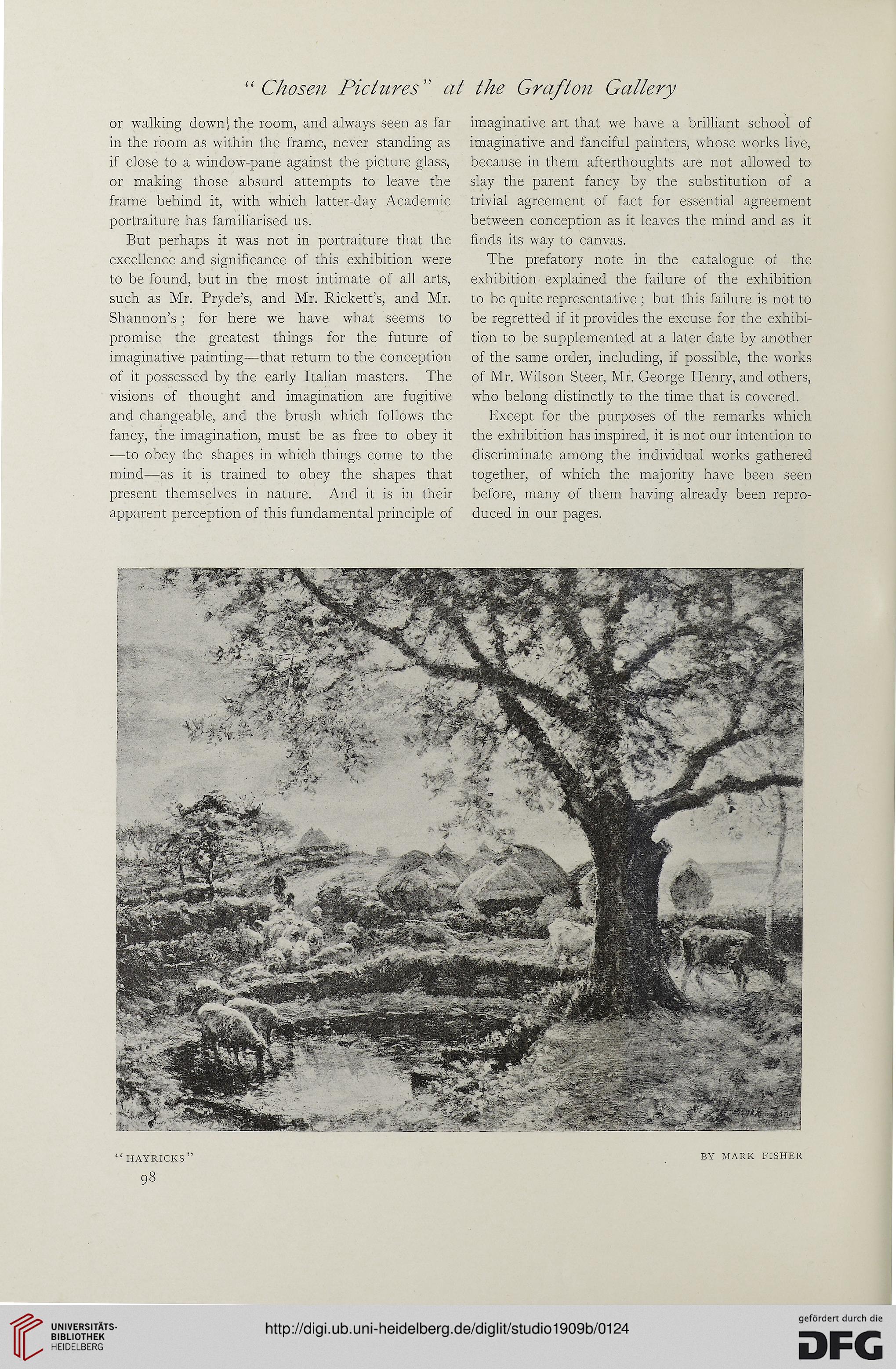“ Chosen Pictures" at the Grafton Galtery
or walking down! the room, and always seen as far
in the room as within the frame, never standing as
if close to a window-pane against the picture glass,
or making those absurd attempts to leave the
frame behind it, with which latter-day Academic
portraiture has familiarised us.
But perhaps it was not in portraiture that the
excellence and significance of this exhibition were
to be found, but in the most intimate of all arts,
such as Mr. Pryde’s, and Mr. Puckett's, and Mr.
Shannon’s; for here we have what seems to
promise the greatest things for the future of
imaginative painting—that return to the conception
of it possessed by the early Italian masters. The
visions of thought and imagination are fugitive
and changeable, and the brush which follows the
fancy, the imagination, must be as free to obey it
—to obey the shapes in which things come to the
mind—as it is trained to obey the shapes that
present themselves in nature. And it is in their
apparent perception of this fundamental principle of
imaginative art that we have a brilliant school of
imaginative and fanciful painters, whose works live,
because in them afterthoughts are not allowed to
slay the parent fancy by the substitution of a
trivial agreement of fact for essential agreement
between conception as it leaves the mind and as it
finds its way to canvas.
The prefatory note in the catalogue of the
exhibition explained the failure of the exhibition
to be quite representative ; but this failure is not to
be regretted if it provides the excuse for the exhibi-
tion to be supplemented at a later date by another
of the same order, including, if possible, the works
of Mr. Wilson Steer, Mr. George Henry, and others,
who belong distinctly to the time that is covered.
Except for the purposes of the remarks which
the exhibition has inspired, it is not our intention to
discriminate among the individual works gathered
together, of which the majority have been seen
before, many of them having already been repro-
duced in our pages.
“ hayricks”
BY MARK FISHER
or walking down! the room, and always seen as far
in the room as within the frame, never standing as
if close to a window-pane against the picture glass,
or making those absurd attempts to leave the
frame behind it, with which latter-day Academic
portraiture has familiarised us.
But perhaps it was not in portraiture that the
excellence and significance of this exhibition were
to be found, but in the most intimate of all arts,
such as Mr. Pryde’s, and Mr. Puckett's, and Mr.
Shannon’s; for here we have what seems to
promise the greatest things for the future of
imaginative painting—that return to the conception
of it possessed by the early Italian masters. The
visions of thought and imagination are fugitive
and changeable, and the brush which follows the
fancy, the imagination, must be as free to obey it
—to obey the shapes in which things come to the
mind—as it is trained to obey the shapes that
present themselves in nature. And it is in their
apparent perception of this fundamental principle of
imaginative art that we have a brilliant school of
imaginative and fanciful painters, whose works live,
because in them afterthoughts are not allowed to
slay the parent fancy by the substitution of a
trivial agreement of fact for essential agreement
between conception as it leaves the mind and as it
finds its way to canvas.
The prefatory note in the catalogue of the
exhibition explained the failure of the exhibition
to be quite representative ; but this failure is not to
be regretted if it provides the excuse for the exhibi-
tion to be supplemented at a later date by another
of the same order, including, if possible, the works
of Mr. Wilson Steer, Mr. George Henry, and others,
who belong distinctly to the time that is covered.
Except for the purposes of the remarks which
the exhibition has inspired, it is not our intention to
discriminate among the individual works gathered
together, of which the majority have been seen
before, many of them having already been repro-
duced in our pages.
“ hayricks”
BY MARK FISHER




